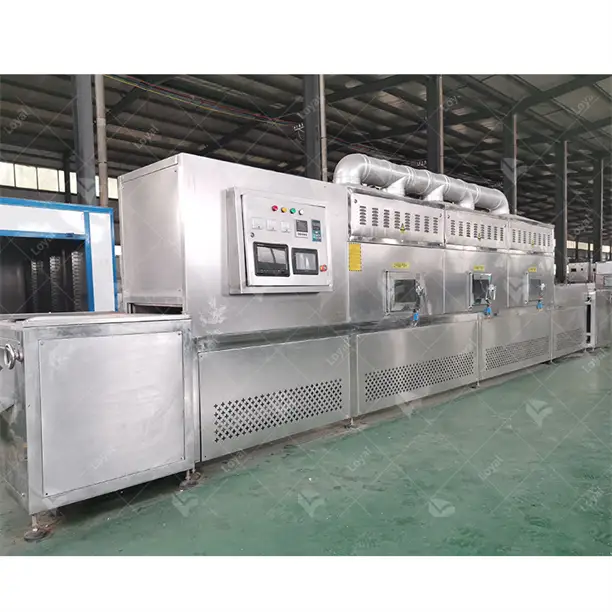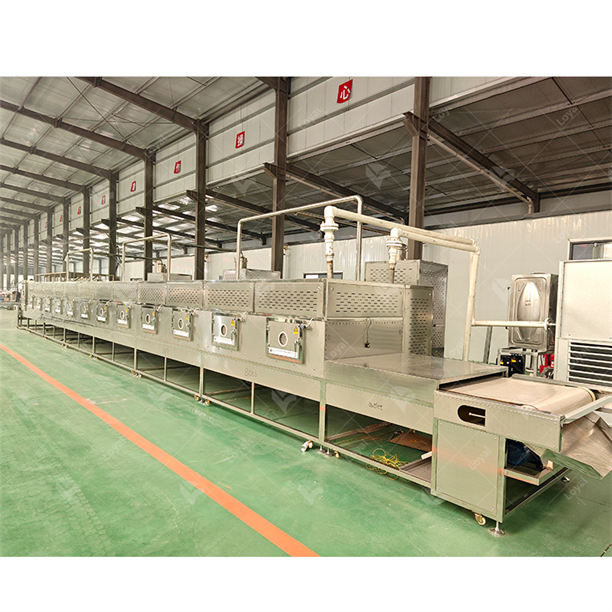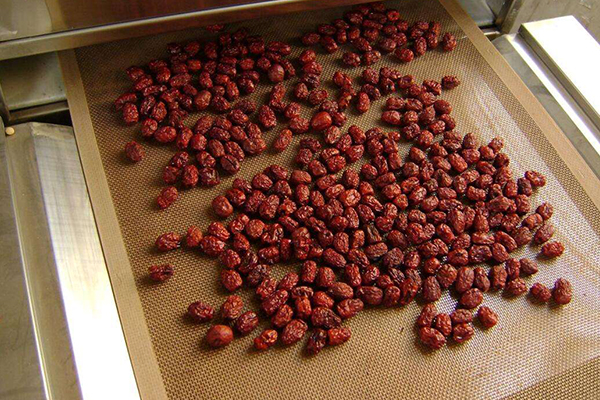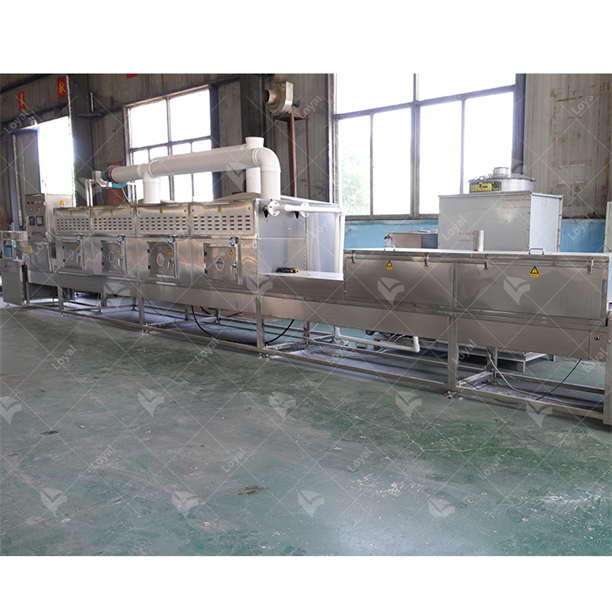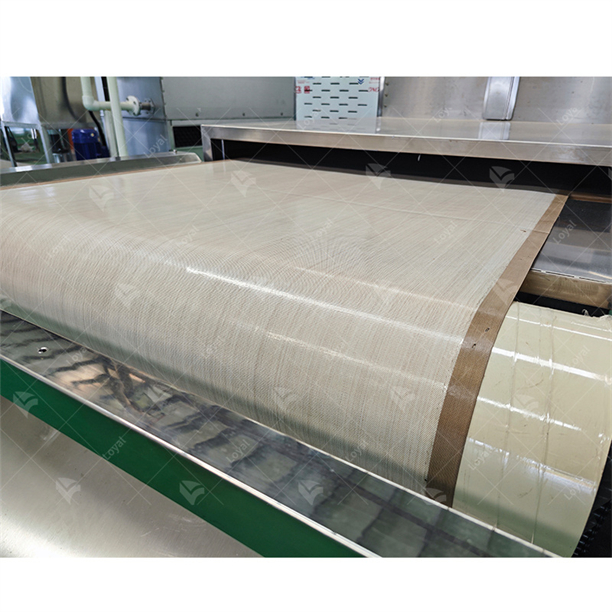Industrial microwave dryers are a cutting-edge answer in drying systems and heating technologies. This manual aims to give a complete outline of microwave drying systems, explaining principles of operation, functionality, and applications across different sectors. These can offer rapid, uniform heating or drying through the material by using various characteristics associated with microwave energy. As will be shown in this article will also delve into the underlying physics of microwave drying as well as look at the various types of microwave dryers that exist and how they are better than traditional methods of drying. In addition, it shall discuss practical aspects one must consider while engaging these systems, such as energy use, operational costs, and maintenance demands. This in-depth examination will give readers full knowledge about industrial microwave dryers and their revolutionary effect on modern production and processing industries.
What is Industrial Microwave Drying?
The technique of industrial microwave drying exploits the microwave energy to heat and dry materials more efficiently and uniformly. In this method, water molecules in the materials are excited by the microwaves that penetrate them making them vibrate rapidly. This rapid vibration causes internal heating and moisture evaporation. Contrary to traditional drying methods, which predominantly focus on surface heating and convection, volumetric heating ensures volumetric heating for steam reduction, hence reducing drying time while ensuring a consistent finish. Due to its ability to retain product quality, optimize energy consumption and improve overall production efficiency, this technology is widely used in many sectors such as food processing, pharmaceuticals, and ceramics.
How Do Industrial Microwave Systems Work?
Industrial microwave systems produce microwaves through magnetrons or solid-state amplifiers, which typically generate high-frequency electromagnetic waves between 900 MHz and 2450 MHz. These waves are directed into a cavity where the dried material is placed. On penetrating the material, microwaves causes polar molecules particularly water to oscillate at high frequencies. Thus molecular agitation transforms microwave energy into thermal energy that heats up the material from inside out homogeneously.
Some important technical parameters associated with industrial microwave systems include:
- Frequency (900MHz-2,450MHz): It determines how deep microwaves can penetrate at different frequencies and also affects the absorption efficiency of water molecules.
- Power Output (up to several kW): Higher power levels are more effective at speeding up drying but must be managed carefully so that overheating or thermal degradation does not occur.
- Microwave Penetration Depth: Depends on dielectric properties of a material and frequency employed varying approximately from one centimeter up to few centimeters.
- Moisture Content: The initial moisture content determines the rate of drying and the ultimate quality of a product.
- Processing Time: This is greatly minimized in comparison with conventional drying approaches because it involves volumetric heating instead
Furthermore, sensors and control units are included in these systems, which regulate drying parameters like temperature, moisture content and microwave power, ensuring accurate and efficient drying while preserving the quality of products. Thus all this capabilities have been tailored to ensure that drying performance is optimized with energy minimized as well as reducing operation costs.
Benefits of Using Microwave Drying Machines
Microwave drying machines are superior to traditional drying methods in several ways. First, they offer significantly reduced processing times through volumetric heating leading to uniform temperature distribution and rapid water removal. This efficiency becomes more important in quick industrial processes. The ability to work at specific frequencies (900 MHz-2,450 MHz) enhances the rate at which water molecules can absorb energy, thus improving drying effectiveness further. Furthermore, the availability of high power output capacity (up to several kW) makes the process even faster although such levels must be managed carefully lest overheating or thermal degradation occur in materials.
Another advantage is in bettering product quality. It eliminates surface overheating, which is typical for ordinary drying techniques. This becomes very crucial when heat-sensitive materials are involved. Controlled temperature, stock content and microwave power by internal sensors and peripheral apparatuses integrated into such systems ensure that dryness does not go beyond optimum operational levels. Additionally, these smart controls maintain structural integrity of commodities while reducing energy consumption (resulting to lower operating costs). Besides this, the penetration depth of microwaves, which can vary from 1 cm to several centimeters depending on a material’s dielectric properties, makes customization possible, leading to greater flexibility and efficacy in different applications. They are known to provide quick processing times, low energy usage, and superior outcomes, hence becoming essential tools in industrial drying.
Comparison with Traditional Drying Methods
When comparing microwave drying systems to traditional drying methods, there are a few technical parameters that expose the good and bad sides of each method. The main focus of convective, conductive and radiant heating methods used in traditional drying lies on passage of heat from hot air/surface to food or any other material being dried up. For instance:
- Energy Efficiency: Since conventional drying methods often take longer durations per treatment volume and exhibit larger energy losses during treatment time, they manifest weaker energy efficiency compared to their microwave counterparts; convective dryers typically run at efficiencies between 30% and 60%, whereas volumetric heating makes it possible for some specific microwave devices to operate with efficiency higher than 80%.
- Drying Time: Unlike traditional techniques which may take hours or even days thus making them unsuitable for certain applications where necessitating shortening the period within which one wants things completely dehydrated within minutes or some hours using microwaves instead. For example, it was discovered through experimental testing that microwave-dried products can be ten times faster than those treated using hot air.
- Temperature Control and Uniformity: Being intrinsically penetrative into materials, microwave systems provide better temperature control and heating uniformity, unlike traditional methods, whose non-uniformity often results in localized overheating, thus deteriorating sensitive products. Temperature gradients in traditional drying can exceed 10°C, whereas microwave drying typically maintains gradients within a few degrees.
- Product Quality: When it comes to product quality, microwave drying is almost free from thermal degradation which is significant in case where heat-sensitive materials are involved. Traditional drying techniques do not allow for such accuracy and precision in regulation of humidity and temperature. Microwave-dried foodstuffs retain more volatile compounds and nutritional contents than air-dried ones.
- Operational Costs: However, even if their initial outlays surpass those of the conventional methods or means, over time they have less operating expenses due to an improved energy efficiency and shorter drying durations. Some traditional means may require extensive time frames and high energy inputs which are translated into increased costs.
To conclude, these five aspects—product quality, operational costs, energy efficiency, temperature control, and drying time—show that microwave dryers have an edge over old-fashioned ways of eradicating water during industrial processing. Various technical parameters have been summarized, proving that this form of drying technology is efficient in industrial applications.
How Does Microwave Drying Technology Improve Efficiency?
Microwave drying technology boosts efficiency in several ways. This is first due to the presence of water molecules that come into direct contact with it, which results in uniform heating and faster moisture removal than conventional methods. Moreover, the accurate control of temperature and moisture levels minimizes the chances of overheating as well as material disintegration, thereby maintaining product quality. Microwave drying systems also require less power thus being more energy efficient when used for drying purposes compared to other systems that consume a lot of electricity for drying purposes and hence becoming expensive and posing a great risk to the environment over time due to emission of substances that may cause global warming. These characteristics collectively account for high performance and efficiency across various industrial applications.
Microwave Drying Techniques for Uniform Drying
Microwave drying techniques for uniform drying are based on the principles of dielectric heating, whereby electromagnetic waves interact directly with water molecules within materials. The resulting volumetric heating engenders evenness in moisture removal. As stated by reliable online sources, some major technical parameters influencing this process include microwave radiation frequency, power density, and exposure time.
In industrial microwave drying, 2.45 GHz is typically considered the optimal frequency because it excites water molecules, thereby accelerating the rapid and uniform drying process. Power density (W/m³) which refers to energy applied per cubic meter needs careful balancing so that we don’t create hotspots or have uneven distribution during drying processes. Recommended power densities vary between 1000 W/m³and 5000 W/m³ depending upon nature of material properties and required rates of drying.
Exposure time is another important parameter, and shorter times are generally preferred to reduce thermal degradation.The literature, along with practical applications, indicates that the length of exposure can vary between a few minutes and an hour depending on the thicknesses involved and how much moisture needs to be removed.
These parameters provide uniformity in terms of dehydration while still protecting the integrity of material by saving energy consumed and ensuring operation efficiency.
Role of Microwave Generators in Efficiency
Microwave generators play an important role in determining the overall efficiency of drying process since they convert electrical energy into microwave energy. They directly affect the homogeneity and speed of drying. Efficiency is mostly influenced by generator’s capability to produce consistent microwave frequencies at required power levels. Good quality microwave generators have low energy losses and better penetration into the material (lessening overall drying time and thus reducing energy usage). Besides this, modern generators utilize techniques such as power modulation and feedback control that improve precision during operations, hence suiting them for different types of materials. In turn, these choices make or break both manufacturing productivity and consistency in dryer batch processes.
Energy Savings with Microwave Energy
Microwave energy offers significant savings on energy compared to conventional drying methods. Microwaves target water molecules within materials directly, resulting in a faster drying process, thus reducing the amount of energy needed to get the desired moisture level in a product. It also takes advantage of lower ambient temperatures, thereby minimizing heat dissipation to the surroundings as well as enhancing its effectiveness through this approach. Furthermore, it is possible to incorporate advanced controls to manage supplies dynamically so that less power goes waste due to unnecessary use. Collectively these factors contribute towards sustainable cost-efficient practices which align with contemporary goals on conservation of energy among othersystems in place today and can be used for drying purposes
What Are the Applications of Industrial Microwave Dryers?
Industrial microwave dryers which are extensively employed in several sectors due to their efficiency and accuracy. They are used in the food industry for drying fruits, vegetables, meats, and ready-to-eat meals in order to remove moisture uniformly while retaining nutritional value and flavor. Besides, they are also used in the pharmaceutical sector for rapidly drying heat-sensitive drugs thereby improving stability and potency of active ingredients. Furthermore, these dryers play a critical role in chemical/materials processing industries where polymers, ceramics, textiles, and composite materials are dried, facilitating shortened processing times and improved product quality.
Food Processing plus Drying Applications
In food processing plus drying applications, industrial microwave dryers have numerous advantages, especially in enhancing drying effectiveness and ensuring the quality of products. Research by leading industry sources shows that microwave drying is much faster than conventional methods often reducing drying time by up to 50%. It is this fast rate of drying that arises from the microwave’s internal heating mechanism, which reduces surface overheating as well as ensures homogenous removal of moisture.
Typical operating frequency quoted frequently involves 2450 MHz which allows penetration into aqueous matrices through efficient energy absorption. Power levels vary from a few kilowatts required for small-scale operations up to hundreds of kilowatts suitable for huge industrial installations, making it scalable according to production requirements. Controlled temperature settings between 40°C and 70°C normally maintain sensory attributes as well as nutrient properties of food thus avoiding degradation that takes place at higher temperatures.
In conclusion, industrial microwave dryers significantly enhance energy optimization and high-quality product realization through their rapid internal heating mode, adjustable power levels, and controlled temperature environments. Therefore, they are indispensable instruments in contemporary food processing, striving for efficiency plus first-rate yields.
Microwave Drying In Plastic And Other Non-Food Industries
This field encompasses plastic among others apart from only focusing on the food sector since there has been widespread use of microwaves in drying. In plastics processing, microwave drying operates at a much higher rate than conventional techniques for drying. Research has shown that microwave drying can significantly reduce the time taken to dry products, leading to improved process efficiency. For instance, microwave radiation is used to dry plastic pellets, which are usually dried within the frequency range of 915 or 2450 MHz and power from 1 kW to several hundred kilowatts, depending on the operation’s scale. These frequencies have been carefully chosen to allow for penetration of energy into plastics thereby ensuring that moisture is removed effectively without causing any thermal degradation.
Lastly, Ceramics and Pharmaceuticals benefit greatly from Microwave Drying technology. The ceramics industry finds uniform drying beneficial as it reduces potential thermal stresses resulting in cracks or warping during final firing. Therefore, microwave drying is employed in pharmaceutical applications in order to meet specific moisture content requirements that impact upon product stability and efficacy. Tightly controlled power levels together with specific temperature settings often based on material characteristics and desired outcomes are standard technical parameters. As an example, different operations may range from 40°C up to 100°C just to maintain the integrity of delicate pharmaceutical compounds.
By tailoring operational parameters such as frequency, power output, and temperature, microwave drying technology has improved efficiency in industrial applications. It is driven by the necessity for quick and even water removal actions that aid high production standards and are economically feasible.
Microwave Sterilisation Application
Microwave technology is being applied increasingly in various industries for sterilisation purposes since it can kill microorganisms without causing a lot of thermal damage to the products. This technique uses focused microwave energy to generate localized heating in the material, disrupting the cellular structures and proteins of pathogenic microorganisms rendering them inactive. In medical and pharmaceutical practices, microwaves are common as a sterilization method for medical instruments, culture media and certain types of packaging.
Frequency bands that are used effectively for microwave sterilization generally include frequencies of 2450 MHz and power outputs ranging from several hundred watts to tens of kilowatts depending on volume and density of materials being sterilized. Temperature settings are very critical especially at 60°C-130°C where complete microbial killing occurs while still maintaining item integrity.
For example, one common way includes using a power density of about 10-20 W/cm³ for about 5-10 minutes at a temperature of approximately 121 °C, albeit by different means, corresponding to conditions used during autoclave sterilization. Sequential or discontinuous radiation with microwave frequencies that oscillate rapidly ensures even heating throughout, thus making sure that all regions, including inner parts, attain appropriate sterility temperatures necessary for processing.
Thus, its adoption is enhanced by its consistency in results delivery, reduced energy consumption, shorter process times, and minimized heat effects on delicate materials, hence serving as an improvement over conventional methods such as autoclaving or chemical disinfection.
What Are the Key Components of an Industrial Microwave Dryer?
An industrial microwave dryer comprises several main components for efficient drying processes, including a magnetron, the source of microwaves for drying, and a waveguide where the microwave energy is uniformly directed to the material being processed. Moreover, the drying chamber functions according to these microwave penetrations, and it is usually made of stainless steel. Other than that, another major part is the conveyor system that moves the material through the microwave field continuously to guarantee even exposure and uniform drying. Control systems are also integrated to monitor parameters like temperature, humidity, and microwave power levels, such as control over temperature, humidity, and power of microwaves, among other things during such processes. The efficiency in this case means removing moisture-laden air from a drying chamber by using ventilation systems so that condensation does not occur.
Microwave Heating Systems and Generators
Microwave heating systems are required to convert electrical energy into microwave energy which can be used in numerous industrial applications. Such systems’ cores consist of magnetrons, or solid-state oscillator generators that generate microwaves. These microwaves then travel via wave guides into heating chambers. Generators play an important role in maintaining frequency stability at either 915 MHz or 2.45 GHz for uniform heating purposes typically. Power control units, together with impedance matching networks, optimize energy transfer to maximize efficiency on the material, especially while integrating advanced models with sensors and feedback loops that dynamically adjust power output for enhanced precision while minimizing wastage associated with energy flow through them. This happens because microwaves penetrate deep into materials, thus reducing processing times and improving throughput.
The Role of Microwave Energy in Drying Systems
Microwave energy has several advantages over traditional methods, making it crucial during drying processes in the form of volumetric heating whereby heat waves penetrate deep into materials, thereby resulting in internal warming rather than surface one compared to conventional methods, leading to a more homogeneous process of drying, thus reducing the risk factors of surface burning or overheating. Due to the rapid power transfer typical for microwaves, this technique significantly decreases drying times, thus improving the throughput and effectiveness of the process itself. Furthermore, microwave energy enables precise control over the drying parameters thereby ensuring better product quality and consistency in addition to that, microwave systems are energy efficient meaning lower operating expenses and less environmental impact compared to traditional ones used in drying.
Advanced Microwave Drying Equipment
Advanced microwave drying equipment has made several major innovations to optimize energy utilization while enhancing drying efficiency. These systems usually come with innovative control interfaces that allow operators to change de-shydrating parameters with utmost accuracy finely. Stable and efficient generation of microwave is characterized by high-frequency transformers together with generator mod-ules. In contrast, reliable transmission of these waves into a chamber is achieved by reinforced waveguides. Additionally, modern versions have incorporated sensors as well as real time monitoring systems that dynamically adjust power levels in order to keep ideal dry-ing conditions. The continuous improvement in these technologies results not only in faster processing times but also higher quality products and significant energy savings compared to conventional dryers.
What Are the Best Practices for Operating Industrial Microwave Dryers?
Certain best practices are to be followed to achieve optimal performance and safety when using industrial microwave dryers. To begin with, it is important that a regular maintenance schedule be adopted, which includes the inspection of some of its components, such as magnetrons, waveguides, and power supplies, to prevent any sudden breakdowns and ensure the process is carried on consistently. Secondly, the machine should be calibrated accurately depending on the material type, moisture content and intended drying results to facilitate uniform drying while maintaining quality. The temperature settings for controlling heating elements and power levels must be monitored strictly in order to avoid overheating or damaging product. On top of this, real-time monitoring systems which integrate sensors can assist in dynamically fine-tuning the process by providing critical data.Lastly, observing safety standards such as having adequate shielding and interlock systems is important in protecting operators from operational hazards as well as microwave exposure.
Safety Measures with Microwave Ovens
Considering safety measures with microwave ovens demands adherence to industry standards and manufacturers’ instructions. Regularly checking door seals, hinges and latches helps to ensure that no radiation leaks from your oven. Proper ventilation prevents overheating and guarantees smooth operation of a device. Operators should always use microwave-safe containers so as not to allow chemical leaching or possible fires; materials like metal or aluminum foil could cause sparks, which would result in burning out the oven.
For industrial microwave ovens safety interlocks must be incorporated which automatically switch off the microwave once you open its doors.Monitoring of emitted microwave radiation level according to such norms like IEEE C95.1-2005 assures maximum allowable limits below 5 mW/cm² 5 cm from external surface. Utilization of real-time monitoring systems may also help detect any anomalies in magnetrons’ operations thereby preventing any dangers.In addition,microwave detection equipment like leakage detectors will result into more secure working conditions for operators during regular inspections.
Maintaining Uniform Drying and Heating
Uniform drying and heating in microwave ovens can be achieved by considering several technical parameters. First of all, it is important to have a good distribution of energy within the cavity generated by microwaves. Using mode stirrers or turntables will ensure that the heat distributed is even thereby avoiding cold and hot spots. The dielectric properties such as permittivity and loss factor for the heated material significantly influence uniformity; materials with high dielectric loss heat faster.
Another important aspect is temperature control. By incorporating temperature sensors coupled with infrared thermography, desired temperatures may be monitored continuously. Real-time feedback and control systems allow for any alterations during heating, thus improving uniformity. Moreover, items placed inside the microwave determine its heating pattern based on their size, shape, and arrangement. For example, thin, evenly spread materials usually warm more uniformly than bulky, thick ones.
For industrial applications, magnetrons and waveguides should be calibrated and performance verified regularly.Valuing uniform field distribution can be measured using E-field method which has an approach to quantify it.However,it is also necessary to ensure that equipment operates at its optimum frequencies which are mostly 2.45 GHz for many of these devices while keeping up with power output’s consistency so as to achieve even heating.This way, the efficiency and effectiveness of microwave heating will be greatly improved, making sure that there are no deviations in the results produced consistently.
Optimization of Microwave Power for Different Applications
Different applications require different approaches to optimizing microwave power that are efficient and give desired results. In the food industry, attention is paid to equal heating as well as retaining nutritional content. Parameters such as frequency, power level, and exposure time are important. Typically, the standard frequency of 2.45 GHz is used while power levels can vary depending on the size and composition of the product in question. Thus, for instance delicate foods require a lower power level (500-700 W) to keep their texture intact and avoid overcooking.
In medical applications, for example hyperthermia treatment in oncology, microwave power is utilized in carrying out some processes. Particularly here precision and control must be deployed to destroy cancer cells while minimizing damage to surrounding tissues selectively. These frequencies range from 915 MHz up to 2.45 GHz with power levels specifically controlled within a range of 50 through 100 watts; also features like real-time temperature monitoring should ensure targeted regions reach therapeutic temperatures between 41 and 45°C.
Lastly, in industrial drying processes such as ceramics or textiles where evenness of moisture content is critical, higher powers are used with specific frequencies. For instance use of freqency at 915 MHz indicates better penetration depth while powers ranges several kilowatts through tens-of-kilowatt figures. Furthermore regulated parameters like uniform ventilation systems , right material positioning,and dynamic moisture monitoring significantly advances drying efficiency and uniformity.
These applications show that optimization of microwave power requires a thorough comprehension of properties of material being treated, desired outcomes and accurate control over technical parameters such as frequency,power level ,and exposure time
How to Choose the Right Industrial Microwave Dryer for Your Needs?
If you want to select the best industrial microwave dryer for your application, several key factors must be taken into account. First, the materials and moisture content one wants to dry should be assessed as they will determine the required frequency and power levels. The amount of material processed by the dryer must also exceed its throughput capacity in line with operational needs. Further, check whether drying is uniform or not so as to avoid unevenness due to which under-drying or over-drying may occur adversely affecting product quality.
The energy efficiency of a microwave dryer should also be evaluated since it affects utility bills. It is important to find out if features such as real-time monitoring and control systems are in place, which allow dynamically adjusting parameters based on real-time feedback, thus optimizing drying processes. Finally, evaluate whether the manufacturer has service/support capabilities so as to ensure reliable maintenance and fast problem solving.
These parameters can be examined in conjunction with the specific drying requirements to identify an industrial microwave dryer that will improve efficiency, ensure good product quality, and be cost-effective.
Considerations for Different Industrial Applications
To this end, understanding different sectors calls for unique suggestive approaches in terms of equipment and procedures associated with microwave drying. For example, one priority in this industry is the preservation of nutritional values together with sensory attributes in food . In order to prevent thermal degradation such that typical densities range from 0.1 W/g up to 2 W/g , frequency and power levels need optimization. At this point, real time control systems prove quite instrumental especially when it comes dynamic adjustment of such parameters as timing or temperature thereby ensuring uniformity throughout without compromising integrity.
For precision and consistency purposes within pharmaceutical industry. Therefore selection criteria for a suitable microwave dryer should focus on ensuring even distribution of heat across active pharmaceutical ingredients preserving their stability. Frequency (about 2450 MHz) during laboratory operations along with power levels need close regulation not lead to the formation of hot spots that would destroy delicate compounds. On this point, advanced monitoring systems come into play as they provide real time information about moisture content and temperatures to maintain strict quality requirements.
In ceramic industry, material dielectric properties and uniform moisture removal necessary for avoiding cracks should be considered while making a choice among various dryers. In most cases, microwave dryers for materials of this kind operate at power levels higher than other sectors, 3-5 kW depending on volume availabilities. The drying rate depends on the dielectric constant and loss factor of the material being heated. It is possible to improve operational efficiency and product quality by integrating scalable systems with fine-grained adjustments of power.
These considerations, combined with advanced technical parameters can help industries optimize their microwave drying process in order to achieve better results within unique operational conditions.
Microwave Drying Solutions Assessment
The evaluation of microwave drying solutions requires a careful examination of a number of key factors to ensure that the technology meets specifications unique to various industries. The first one is energy efficiency which has great implications for costs and the environment. Energy wastage can be trimmed by high-efficiency microwave dryers, which convert more electrical energy into microwaves. Furthermore, uniformity in heating is crucial; advanced microwave systems should possess technologies that minimize hotspots and guarantee equal moisture elimination throughout the product. Hence, properties such as frequency change and real-time supervision could provide avenues towards this end. Lastly, we cannot forget about the adaptability and scalability of these kinds of dryers. The most appropriate ones are those that could be modified with ease in order to accommodate various sizes of batches and types of products without huge effects on their performance levels. These considerations correspond with prevailing industry’s best practices as well as contemporary technological advancements pointed out by leading practitioners in the field.
Frequently Asked Questions (FAQs)
Q: What are the key advantages of using microwave drying and heating systems over traditional methods like drying rooms and convection ovens?
A: Microwave drying and heating systems offer several advantages including quicker drying times, energy efficiency, uniform drying effect, and reduced risk of material degradation compared to traditional methods like drying rooms and convection ovens.
Q: How do industrial microwave generators work in the context of microwave drying and heating?
A: Industrial microwave generators produce electromagnetic waves, primarily at frequencies of 915 MHz or 2450 MHz, which interact with the water molecules in the material being dried. This interaction causes the water molecules to oscillate and evaporate, leading to efficient drying rapidly.
Q: What types of materials can benefit from microwave treatment in industrial processing?
A: Microwave treatment is versatile and can be applied to various materials including food products, pharmaceuticals, ceramics, textiles, and building materials. It helps in achieving uniform drying and setting processes for these applications.
Q: How does microwave drying achieve more uniform drying compared to traditional methods?
A: Microwave drying achieves more uniform drying by directly interacting with the water molecules throughout the material, ensuring even energy distribution and preventing uneven drying that is common with traditional methods.
Q: Can microwave drying and heating systems be integrated into existing industrial processing lines?
A: Yes, many industrial microwave generators and microwave heating and drying systems are designed to be easily integrated into existing industrial processing lines, thereby enhancing efficiency and reducing downtime.
Q: What are the safety considerations for using microwave techniques in industrial drying processes?
A: Safety considerations include ensuring proper shielding and insulation of the microwave equipment, regular maintenance of the dryer machine, and adherence to safety standards and regulations to prevent exposure to microwave radiation.
Q: How can one determine the suitability of microwave drying for a specific material or process?
A: To determine the suitability of microwave drying, it is recommended to conduct pilot tests and consult with experts in microwave drying and heating technologies. You can also reach out to providers of industrial MW systems for guidance.
Q: What are the economic benefits of using industrial microwave generators for commercial enterprises?
A: The economic benefits include reduced energy costs, faster processing times, higher product quality, and less waste. Additionally, microwave drying is quicker, which can increase throughput and lead to higher production rates.
Q: Where can I get more information or assistance with implementing microwave drying techniques?
A: For more information or assistance, it is best to contact us directly or refer to providers specialized in industrial microwave generators and related technologies. They can provide tailored solutions and technical support for your specific needs.













